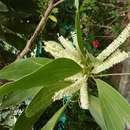Acacia is a genus of shrubs and trees, often spine-bearing, that belongs to the subfamily Mimosoideae (family: Fabaceae). The fruits are the seed-bearing pods typical of Fabaceae (formerly Leguminosae). The generic name derives from ακακία (akakia, from ακις [akis, thorn]). Until recently, ~1300 species worldwide were classified as
Acacias—about 960 native to Australia, with the remainder in tropical to warm-temperate regions of Europe, Africa, southern Asia, and the Americas. However, in 2005, taxonomists divided
Acacia into five separate genera:
Acacia (the Australian species, with a few in tropical Asia, Madagascar and Pacific Islands);
Vachellia and
Senegalia (which include most species outside Australia); and
Acaciella and
Mariosousa (which each contain about a dozen species from the Americas). Acacia leaves are generally compound pinnate. In some species, however, the leaflets are suppressed, and the leaf-stalks (petioles) become vertically flattened into phyllodes, oriented vertically to avoid intense sunlight. Some species (such as
A. glaucoptera) lack leaves or phyllodes altogether, but possess instead cladodes, modified leaf-like photosynthetic stems functioning as leaves. Various species have sap that hardens into gum. Flowers are small with five petals, almost hidden by 10 (or more) long stamens, and arranged in dense globular or cylindrical clusters; they are generally yellow or cream-colored, but can be white, purple, or red. Acacias have diverse and extensive uses, ranging from food (many species contain edible shoots and seeds, and the flowers are used to produce a delicate and non-crystallizing honey) and medicine to paint and perfume to timber and firewood. The leaves of many species bear large amounts of tannins, with wide commercial production for tanning leather. In the North America and Europe, acacia ingredients are used in soft drinks, chewing gums, candies, and mints. The sap of
A. senegal and
A. seyal yields gum arabic, which is used in foods, paints, inks, cosmetics, hair products, textiles, and numerous other products (Wikipedia 2011). Acacias are used to make incense, and may have been the “burning bush” of the Bible and the wood used to construct the Ark of the Tabernacle. Many acacias produce alkaloid chemicals as defensive compounds to deter insects and mammalian herbivores. Some of these alkaloids are toxic to livestock, while others have psychoactive properties. Acacias interact in various well-known mutualisms, such as one in which swollen thorn acacias of Costa Rica offer food and shelter to ants in exchange for protection from plant competitors and insect herbivores (Janzen 1966). (See National Geographic video,
http://video.nationalgeographic.com/video/player/animals/bugs-animals/ants-and-termites/ant_acaciatree.html.) In another notable mutualism, acacia seeds that pass through the gut of large mammalian herbivores (such as elephants) are more likely to germinate—not because the digestive juices soften the hard seed coat, as previously thought, but because they kill the Bruchidae beetle larvae that parasitize most uneaten seeds (Attenborough 1995, Palmer et al. 2008); see ARKive video of a bruchid beetle eating seeds of
A. tortilis (
http://www.arkive.org/umbrella-thorn/acacia-tortilis/video-11b.html).

